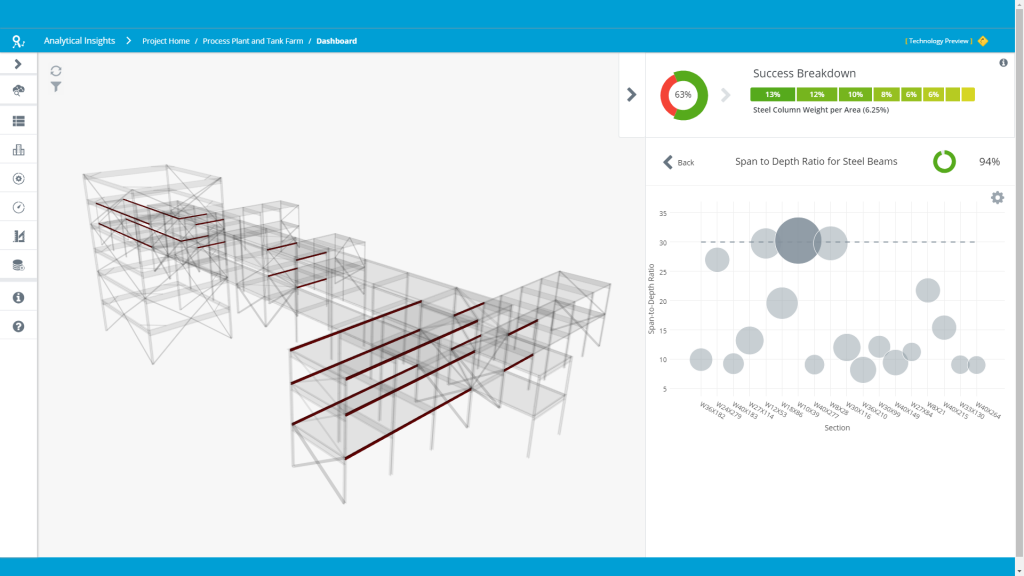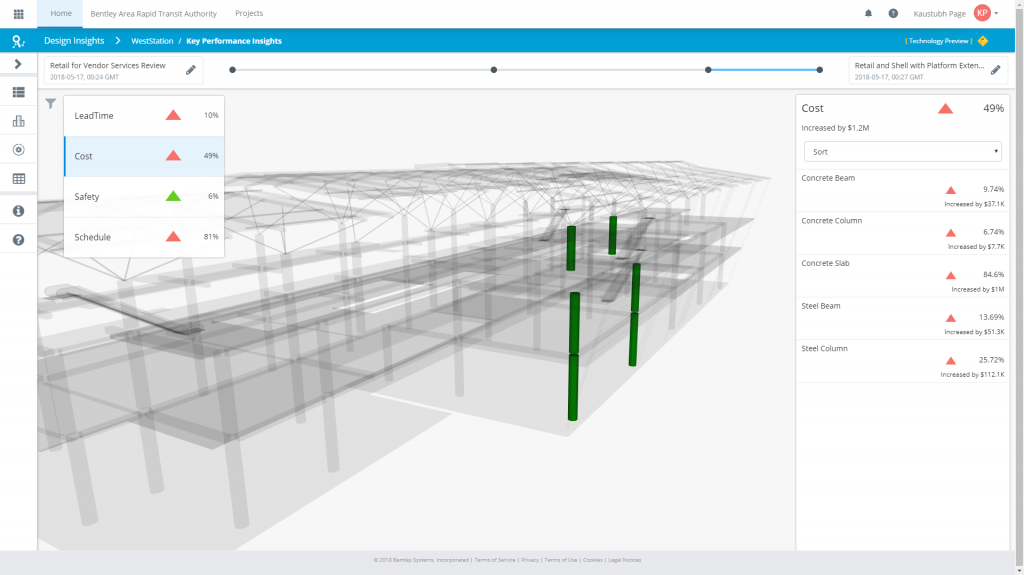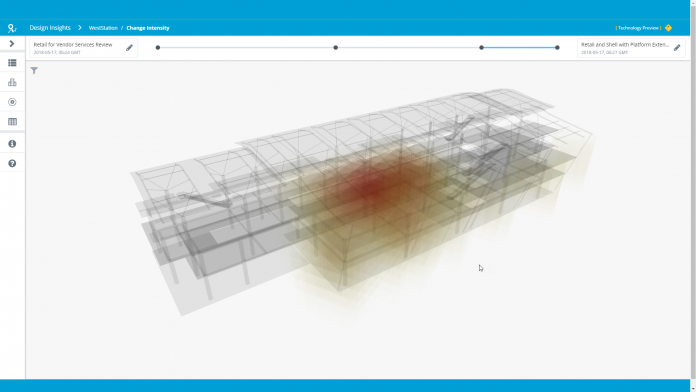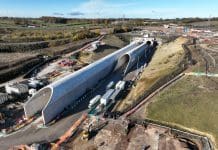Cloud services and machine learning can help engineers boost productivity, performance and predictability. Raoul Karp and Kaustubh Page of Bentley Systems explain how
Engineers have always embraced new technology to improve the performance, safety and cost of the structures that they put their stamp on.
With the digital revolution, structural engineers were some of the first to use mainframe computing to understand complex structural behaviour. The personal computing and internet evolution democratised computation and delivered a paradigm shift in how engineers collaborate and communicate. Engineering firms have made radical increases in productivity by adopting digital workflows that encompass all aspects of their technical business, including analysis, design, documentation and even downstream activities like detailing and fabrication.
We now stand at the precipice of the next major advancement in the technology revolution – cloud services. Cloud services promise three fundamental dimensions of value to the engineering profession: virtually endless compute power, improved collaboration and performance-improving insight through learning from your firm’s collective digital experiences. It is an exciting new era that structural engineers must embrace if they want to meet the increasing demand for efficient, sustainable and resilient infrastructure that our society expects.
Plug into the power
We have moved from an era of large mainframes – where engineers spent a day entering punch cards and another day waiting to learn if they made a mistake and had to start again – to analysing skyscrapers on a desktop in half the time.
Our structures are getting bigger and more complex while our cities grow more congested, demanding growth on to more challenging geotechnical surfaces. In addition, we must meet increasing environmental hazards and community resilience demands. The need to efficiently design under these conditions, and remain productive and profitable, demands new power not likely achieved through conventional desktop computing.
To put compute demand into perspective, consider a small frame structure and the number of floating point operations required to solve the elastic finite element analysis for a single, static load case. Fifty years ago, processing this analysis would have taken a day with a huge computing power cost. Now, with multiple cores on a single processor, the same analysis takes seconds.
Consider a more realistic structure with walls, floors and thousands to millions of degrees of freedom; nonlinear material requiring continuous recalculation of stiffness matrices; and subject to dynamic seismic or hurricane events in multiple directions.
To achieve productive design in these instances, engineers typically make conservative simplifications to their idealisation of the structure, soil, material and loads. Yet they still require hours of compute time and produce gigabytes of data to be post-processed.
To productively perform these kinds of simulations and explore the design space for the most efficient solution requires a revolutionary leap in compute power. Unfortunately, the doubling of compute power every couple of years, as promised by Moore’s law, cannot keep up with the physics of size. This situation prompted The Economist to state that: “The main unit of analysis is no longer the processor, or the number of transistors that can be squeezed on a chip, but the number of servers in a rack or data centre size itself.”
Cloud services, including Bentley’s Scenario Services, which leverages Microsoft’s secure Azure platform, enable engineers to perform complex tasks (such as wind turbine analysis for many wind and wave loading conditions) in parallel, reducing what used to be a multi-day process to a few hours.
 For instance, innovative post-tension slab design software (RAM Concept) uses genetic algorithms to optimise the geometry of tendon layout with cloud services, saving engineers days on a typical flat slab design. Using structural analysis and design software such as STAAD, engineers can analyse their structures in the cloud as well as consider multiple design scenarios in parallel. They can also perform trade-off analysis between the designs and their performance with all stakeholders through the web visualisation interface.
For instance, innovative post-tension slab design software (RAM Concept) uses genetic algorithms to optimise the geometry of tendon layout with cloud services, saving engineers days on a typical flat slab design. Using structural analysis and design software such as STAAD, engineers can analyse their structures in the cloud as well as consider multiple design scenarios in parallel. They can also perform trade-off analysis between the designs and their performance with all stakeholders through the web visualisation interface.
It takes a village
Design projects involve a multitude of different disciplines, stakeholders and distributed organisations working together. Every decision made on a project has implications, if not to another discipline then to the project cost, schedule and risk. If change is a constant of projects, we want to make the most informed decisions relative to project objectives, requiring systems and applications that can help us coordinate, collaborate and manage that change efficiently.
Cloud services are the ideal technology to help deliver these needs. We must synchronise work from various project members, using any number of desktop products from a multitude of software providers. To move from a world of files and documents held in disconnected digital silos to one that is secure, scalable and reusable, we need to address the three A’s in a common service: Alignment, Accountability, Accessibility.
Bentley’s iModelHub is a cloud technology platform that addresses the three A’s. Housed in Microsoft’s secure Azure cloud service, iModelHub is built from the ground up with change and scale as fundamental constructs. Authorised project members can use their existing desktop products from multiple vendors and send change sets to the iModelHub, where data is aggregated, aligned and shared in a web interface. Stakeholders can visually understand changes made from all project contributors.
With data aligned across all source products, engineers can develop analytics to expose the impact of change. Design Insights on iModelHub shows the impact of change on key project performance indicators like relative cost, schedule and volume. The ramifications of design changes are now understood by all stakeholders when decisions are being made, rather than afterward.
As iModelHub brings accountability and alignment to the data, various cloud services built on top of the platform compare the current state of the project with any past snapshot in time. For example, data gathered from multiple sources can be visualised to highlight the intensity and location of changes between any two phases of the project.
With data aligned and aggregated in one platform with open analytics, the stakeholders can make better informed decisions for better project outcomes.
 Take off the training wheels
Take off the training wheels
Seventy-five percent of engineering firms report applying their own performance requirements beyond what the code mandates. How does your firm ensure that lessons learned on every project in your organisation are captured and institutionalised, not to be repeated?
In the next decade, the fastest-growing segment of the US labour force will be those individuals nearing retirement at 60 years and older. The collective experience of a firm is captured in all the project data, the performed calculations, the completed designs and the built structures. Gaining insight and using this knowledge to educate and inform engineering decisions is both the challenge and potential of machine learning.
Expert systems can be deployed to try and capture a firm’s collective experience. Lessons learned are captured in knowledge management systems and best practices are developed and enforced through quality assurance and quality control manual review processes.
Some cloud services, such as Bentley’s Design Insights, allow firms to automate the process of institutionalising and enforcing best practice rules. Designers can perform code compliance checks using structural design software and further enhance the design quality by checking their model against best practice guidelines of an engineering firm. The design’s constructability, efficiency and performance are evaluated relative to specified outcomes and priorities using a cloud service. Results of the evaluation help designers identify the most critical areas to improve the design performance, and allow stakeholders instant access to the progress through a cloud service. Managers can review design progress without needing to run a complex desktop finite element solution or reviewing a set of drawings.
Expert systems are only as good as the processes used to capture experience, establish standards and enforce compliance. Each step is a potential weak link in the process.
But what if a machine could learn from all the designs, drawings and project results that your firm previously performed, identifying what characteristics resulted in the most successful projects? That day is here and so is the promise of machine learning and new deep learning software algorithms.
Conclusion
There is tremendous pressure on structural engineers to produce safer, more economic structures in less time and with a tighter budget. Engineers have a choice – stick with the status quo and potentially risk obsolescence, or adopt new applications and services to better differentiate their services and outcomes. Cloud services can make a difference to your performance and profitability, whether by optimising analyses and designs in less time, reducing schedule and risk with a collaborative cloud platform, or taking advantage of new software intelligence to extract important insights.
Raoul Karp
Vice-president, Design Engineering Analysis
Bentley Systems
Tel: +1 610 458 5000
Twitter: @bentleysystems
Facebook: BentleySystems
Kaustubh Page
Senior Product Manager
Bentley Systems
Tel: +1 610 458 5000
Twitter: @bentleysystems
Facebook: BentleySystems











![[VIDEO] Cambridge waste water plant granted permission to relocate Artist impression of the new Cambridge waste water plant and surrounding land](https://www.pbctoday.co.uk/news/wp-content/uploads/2025/04/p.151-768x364-1-218x150.jpg)


